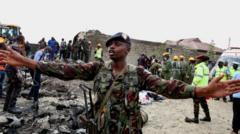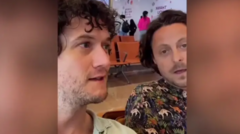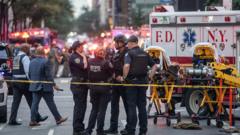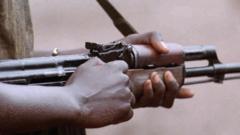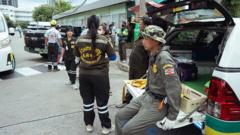The recent jet crash in Ahmedabad serves as a grim reminder of the fragility of life as it claimed several victims, disrupted a community, and raised questions about safety standards in aviation.
Tragedy Strikes: Ahmedabad Jet Crash Claims Lives, Shatters Community

Tragedy Strikes: Ahmedabad Jet Crash Claims Lives, Shatters Community
The devastating crash of Air India Flight AI171 near BJ Medical College leaves community in disarray as rescuers cope with the aftermath.
The sound of jet engines roared ominously over a tranquil afternoon at BJ Medical College's residential hostel, where students were enjoying lunch and camaraderie. At precisely 13:39 local time, the peaceful setting transformed into a nightmare as Air India Flight AI171, shortly after departing for London, encountered catastrophic failure.
Witnesses recalled a thunderous noise, likening it to thunder rather than a jet engine, as chaos erupted on the campus. The state-of-the-art Air India 787 Dreamliner, carrying 242 passengers, sent shock waves through the vicinity seconds after taking off from Ahmedabad airport, which is a mere 1.5 kilometers away from the bustling hostel.
Eyewitness accounts described a dire scene: students and medical professionals sprinting toward the origin of the sound, unaware of the devastation awaiting them. "At first, we thought it might have been lightning," recounted a doctor working close by. Once outside, the sight was horrifying: "a plane has crashed into our building," echoed amidst the pandemonium.
Brothers Prince and Krish Patni, who were nearby, rushed toward the site but faced searing heat that forced them to wait before attempting to help. As they gained access to the wreckage, they were overwhelmed by the sight of the injured—students caught amidst the debris, still clutching their lunch.
One survivor recalled how, moments before, they were engaged in normal conversation. Suddenly, everything changed. He described the shock of being trapped under debris, with flames and smoke urging them to escape.
Accounts detail the severity of the damage, particularly where parts of the plane collided with the building, leading to heroic yet desperate acts as individuals sought to aid one another. Survivors sprang from higher levels, indicating the urgency to flee the scene of destruction as stairwells became impassable.
As rescue operations unfolded, community members rallied for support but were left with grim realizations about the loss of life. Several students from the college, along with their relatives, were confirmed dead, with counts still pending as authorities await DNA identification for formal confirmations.
The somber atmosphere at the college extended to Ravi Thakur, a local kitchen worker who rushed home upon hearing the news, only to find his wife and child missing amidst the chaos—raising haunting questions about accountability and future safety protocols within the aviation sector.
As the community mourns, educators are left grappling with the significance of these lives lost and the lingering impact on those who survived. They emphasize the ongoing need to care for the injured students as they continue to search for answers and solace amid tragic loss.
In this unfolding narrative, the air of despair underscores a critical moment for reflection—how aviation safety practices will need to evolve to prevent future incidents of such magnitude and how communities can prepare for the unthinkable.
Witnesses recalled a thunderous noise, likening it to thunder rather than a jet engine, as chaos erupted on the campus. The state-of-the-art Air India 787 Dreamliner, carrying 242 passengers, sent shock waves through the vicinity seconds after taking off from Ahmedabad airport, which is a mere 1.5 kilometers away from the bustling hostel.
Eyewitness accounts described a dire scene: students and medical professionals sprinting toward the origin of the sound, unaware of the devastation awaiting them. "At first, we thought it might have been lightning," recounted a doctor working close by. Once outside, the sight was horrifying: "a plane has crashed into our building," echoed amidst the pandemonium.
Brothers Prince and Krish Patni, who were nearby, rushed toward the site but faced searing heat that forced them to wait before attempting to help. As they gained access to the wreckage, they were overwhelmed by the sight of the injured—students caught amidst the debris, still clutching their lunch.
One survivor recalled how, moments before, they were engaged in normal conversation. Suddenly, everything changed. He described the shock of being trapped under debris, with flames and smoke urging them to escape.
Accounts detail the severity of the damage, particularly where parts of the plane collided with the building, leading to heroic yet desperate acts as individuals sought to aid one another. Survivors sprang from higher levels, indicating the urgency to flee the scene of destruction as stairwells became impassable.
As rescue operations unfolded, community members rallied for support but were left with grim realizations about the loss of life. Several students from the college, along with their relatives, were confirmed dead, with counts still pending as authorities await DNA identification for formal confirmations.
The somber atmosphere at the college extended to Ravi Thakur, a local kitchen worker who rushed home upon hearing the news, only to find his wife and child missing amidst the chaos—raising haunting questions about accountability and future safety protocols within the aviation sector.
As the community mourns, educators are left grappling with the significance of these lives lost and the lingering impact on those who survived. They emphasize the ongoing need to care for the injured students as they continue to search for answers and solace amid tragic loss.
In this unfolding narrative, the air of despair underscores a critical moment for reflection—how aviation safety practices will need to evolve to prevent future incidents of such magnitude and how communities can prepare for the unthinkable.




